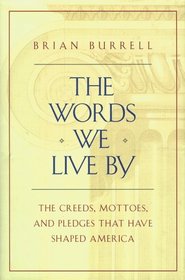This book is an excellent comglomoration of almost every known motto, oath, pledge, etc that would concievably fall under the heading "Words We Live By."
An excellent bathroom reading for the history nerd in all of us...
Amazon.com review:
Brian Burrell's book, "The Words we Live By" is a unique and quirky resource. Within its pages he follows in his father's path, collecting and attempting to understand the creeds, mottoes and pledges that have shaped the United States. Burrell's book starts with the Golden Rule, and notes how it has been mentioned by all major religions, and mentioned by those with none. He also discusses oaths, the Pledge of Allegiance, family mottoes, and even words carved in stone upon our public buildings.
With such diverse sources Burrell has quite a task, and attempts to categorize the various sayings, creeds, calls, and business codes of ethics into a coherent package. For the most part he is successful, although there is some redundancy in the text. But for those of us who enjoy ethics, and who wish to understand what motivates people to perform at their best, this book is a rare and interesting resource. Where else could you find The Hippocratic Oath, The Declaration of Principles of the Pacific Ice Cream Manufacturer's Association, AND the text carved upon the Tomb of the Unknown Soldier?
The book is well footnoted, and contains valuable pictures of some monuments or other visual sources discussed. It can be read from cover-to-cover, or enjoyed as a casual pick-up book. With such a expansive document, some items are omitted, and sometimes more detail would be appreciated. For instance, it would have been interesting if he had discussed more how monuments can distort words or events. Nevertheless, this book will provide those interested in ethical standards and guiding principles embedded within society a terrific and valuable reference. It is a pleasure to recommend this book.
An excellent bathroom reading for the history nerd in all of us...
Amazon.com review:
Brian Burrell's book, "The Words we Live By" is a unique and quirky resource. Within its pages he follows in his father's path, collecting and attempting to understand the creeds, mottoes and pledges that have shaped the United States. Burrell's book starts with the Golden Rule, and notes how it has been mentioned by all major religions, and mentioned by those with none. He also discusses oaths, the Pledge of Allegiance, family mottoes, and even words carved in stone upon our public buildings.
With such diverse sources Burrell has quite a task, and attempts to categorize the various sayings, creeds, calls, and business codes of ethics into a coherent package. For the most part he is successful, although there is some redundancy in the text. But for those of us who enjoy ethics, and who wish to understand what motivates people to perform at their best, this book is a rare and interesting resource. Where else could you find The Hippocratic Oath, The Declaration of Principles of the Pacific Ice Cream Manufacturer's Association, AND the text carved upon the Tomb of the Unknown Soldier?
The book is well footnoted, and contains valuable pictures of some monuments or other visual sources discussed. It can be read from cover-to-cover, or enjoyed as a casual pick-up book. With such a expansive document, some items are omitted, and sometimes more detail would be appreciated. For instance, it would have been interesting if he had discussed more how monuments can distort words or events. Nevertheless, this book will provide those interested in ethical standards and guiding principles embedded within society a terrific and valuable reference. It is a pleasure to recommend this book.




